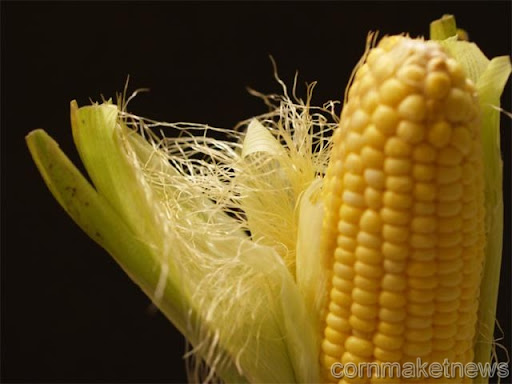Thursday, April 7, 2011
Corn Seen Outperforming Wheat, Soybeans, Cotton as China Doubles Imports
 Corn may outperform wheat, soybeans and cotton in the three months to June as imports by China double, according toBarclays Capital.
Corn may outperform wheat, soybeans and cotton in the three months to June as imports by China double, according toBarclays Capital.
“The problem really is that we haven’t seen any let up in Chinese demand,” Sudakshina Unnikrishnan, an analyst at Barclays Capital, said by phone yesterday. Risks to the U.S. crop from snow and cooler weather and increased global demand may help push corn to a record $10 a bushel, Macquarie Group Ltd. said. That’s 30 percent more than the price today.
Corn more than doubled in the past year as consumption outstripped harvests, draining stockpiles and fanning food-price inflation. There’s “rampant demand” for agricultural commodities from China, Rabobank Groep NV said in a report in December, backing corn to drive grain prices higher in 2011.
Imports by China “could be as high as 2.5 million metric tons, easily double that of last year,” said London-based Unnikrishnan, who correctly predicted in November that increased cotton purchases by China would help drive prices to an all-time high. China is “increasingly becoming more reliant on imports because of domestic diet conditions and inventories,” she said.
Corn, which was at $7.67 per bushel on the Chicago Board of Trade at 2:37 p.m. in Singapore, has gained 115 percent over the past 12 months. Wheat has rallied 68 percent to $8.22 per bushel and soybeans have risen 45 percent to $13.8125 per bushel. Global food prices reached a record in February, according to a United Nations’ gauge that surged 34 percent in the past year.
China’s corn imports are forecast at 1 million tons in the year to Sept. 30, according to a report from the U.S. Department of Agriculture last month. The country may purchase as much as 15 million tons from overseas by 2015, according to a forecast from Shanghai JC Intelligence Co. last July.
Protein Demand
Rising incomes in China are increasing demand for protein, boosting meat consumption and demand for corn as animal feed. The world’s second-largest economy expanded an average of 11 percent over the past five years.
“The pressure is still on feed grains,” Jing Ulrich, chairwoman of China equities and commodities at JPMorgan Chase & Co., said at a media briefing in Singapore on April 5. “People are getting wealthier so they eat more meat. That’s why you need feed, soybeans and corn to feed the livestock with.”
In the U.S., the largest corn exporter, cooler weather in the Midwest may derail planting, Alexander Bos, an analyst at Macquarie, said yesterday in an interview on Bloomberg Television’s “Surveillance Midday” with Tom Keene. Rising ethanol demand may also boost corn, Bos said.
‘Serious Problem’
“If that happens, I think we have a serious problem developing on the U.S. corn balance sheet,” Bos said. “I think that opens up certainly upside to $8.50, $9. In a kind of a worst-case scenario, certainly $10 becomes possible.”
Demand for corn from ethanol producers may rise to 4.95 billion bushels in the year to Aug. 31, from 4.57 billion a year ago, according to a March estimate from the USDA. That’s equal to about 40 percent of the harvest, according to USDA data.
Farmers in the U.S. plan to expand corn sowing to 92.178 million acres this year, the second-largest area since 1944, encouraged by higher prices, the USDA said March 31, citing a survey of growers’ intentions.
Snow cover in parts of the Midwest, the largest U.S. corn- and soybean-growing region, may cause floods when it melts, Michael Ferrari, vice president for applied technology and research at Weather Trends International, said in a phone interview today. That may make it difficult for machinery such as tractors to prepare land for planting, Ferrari said.
‘Gets Shut Off’
“The impact is that you’re delaying the planting,” Ferrari said. “At some point, the corn-planting window gets shut off,” prompting farmers to switch to soybeans, he said.
In China, state corn inventories may fall to 10 million to and 12 million tons, “less than previously thought for the 2011-2012 season,” U.S. Grains Council President Thomas C. Dorr said in an April 5 website statement, without saying who had provided the figure and without giving a year-ago number.
Price controls in China have helped made it unattractive for importers to seek overseas supplies at present, Jay O’Neil, an adviser to the grains council, said by phone on April 6.
“They are holding their orders, waiting and watching the market,” said O’Neil, who met with private feed millers in China three weeks ago. Chinese buyers may seek overseas supplies from June, when domestic harvests start to dry up, pushing local prices higher, he said.

This post was written by: HaMienHoang (admin)
Click on PayPal buttons below to donate money to HaMienHoang:
Follow HaMienHoang on Twitter













0 Responses to “Corn Seen Outperforming Wheat, Soybeans, Cotton as China Doubles Imports”
Post a Comment